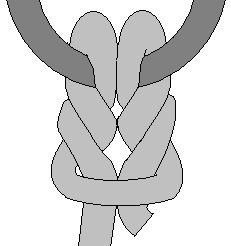Category Hitch Releasing Non-jamming | Origin Ancient ABoK #1891 | |
 | ||
Related Typical use Attaching a rope to a hook or ring | ||
The Cat's paw is a knot used for connecting a rope to an object. It is very similar to the cow hitch except there is an additional twist on each side of the bight, making it less prone to slipping.
Contents
Uses
Comments
In one method of tying, it can be pre-formed in the middle of the rope, then slid over the end of a post or rail.
In an alternative method, a line with an accessible end and an eye can be attached to another eye, ring or rail with inaccessible ends.
The knot balances the load between the two hitches, and is used in wharfs and docks. If one hitch fails, the other hitch should hold until the load can be safely and swiftly lowered to the ground.
Structure
Formed from a bight turned up over itself (like a girth hitch) but with an extra twist on each side. In variations, there may be multiple extra twists.
Method 1
Form a bight in the middle of the line, and pull it back over itself like a girth hitch. This forms two loops, turned in opposite directions. Convert each loop into an elbow by adding a twist in the direction that will tend to tighten them (the wrong direction will undo the loop completely). Pass both elbow over the hook, rail or post and pull tight, taking care to push the bight up snugly against the turns.
Method 2
If working end of the line has an eye in it, and the standing end is accessible, the knot can be tied to a closed ring, another eye, or a rail with inaccessible ends, as follows. Pass the eye around the ring or rail, then pass the standing end through its own eye (this effectively forms a girth hitch). Then pass the standing end through the eye again, and pull up tight, taking care to push the bight up snugly against the turns.
When using the cat's paw to join two eyes, this process may be repeated several times to give several turns - as many as five in a fine fishing monofilament. Then when tightened, instead of pulling the bight up against the turns, both eyes are pulled equally, to make neat coils of turns in both eyes, meeting halfway between them.
